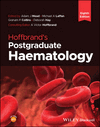Rare inherited coagulation disorders
Flora Peyvandi
Angelo Bianchi Bonomi Hemophilia and Thrombosis Center, Fondazione IRCCS Ca’ Granda Ospedale Maggiore Policlinico, Università degli Studi di Milano, Milan, Italy
Search for more papers by this authorMarzia Menegatti
Angelo Bianchi Bonomi Hemophilia and Thrombosis Center, Fondazione IRCCS Ca’ Granda Ospedale Maggiore Policlinico, Università degli Studi di Milano, Milan, Italy
Search for more papers by this authorFlora Peyvandi
Angelo Bianchi Bonomi Hemophilia and Thrombosis Center, Fondazione IRCCS Ca’ Granda Ospedale Maggiore Policlinico, Università degli Studi di Milano, Milan, Italy
Search for more papers by this authorMarzia Menegatti
Angelo Bianchi Bonomi Hemophilia and Thrombosis Center, Fondazione IRCCS Ca’ Granda Ospedale Maggiore Policlinico, Università degli Studi di Milano, Milan, Italy
Search for more papers by this authorAdam J Mead PhD, FRCP, FRCPath, FMedSci
Haematopoietic Stem Cell Biology Laboratory, Medical Research Council Molecular Haematology Unit, Medical Research Council Weatherall Institute of Molecular Medicine, University of Oxford, Oxford, UK
Search for more papers by this authorMichael A Laffan DM, MRCP, FRCPath
Department of Immunology and Inflammation, Faculty of Medicine, Imperial College London, London, UK
Search for more papers by this authorGraham P Collins DPhil, FRCP, FRCPath
Department of Haematology, Oxford Cancer and Haematology Centre, Oxford, UK
Search for more papers by this authorDeborah Hay DPhil, MRCP, FRCPath
Nuffield Division of Clinical Laboratory Sciences, Radcliffe Department of Medicine, University of Oxford, Oxford, UK
Search for more papers by this authorA Victor Hoffbrand MA, DM, FRCP, FRCPath, FRCP (Edin), DSc, FMedSci
Emeritus Professor of Haematology Honorary Consultant Haematologist
University College London, London, UK
Royal Free Hospital, London, UK
Search for more papers by this authorSummary
Rare coagulation disorders are due to the lack of coagulation proteins, except coagulation factor VIII, IX and von Willebrand factor, and may cause abnormal bleeding, also severe and unprovoked. Their incidence in the general population varies from 1 in 500,000 to 1 in 2 million depending on the deficient protein. This incidence may be higher in countries where consanguineous marriages are customary. The most common clinical symptoms are mucosal tract bleeding and excessive bleeding at the time of invasive procedures, delivery in women and circumcision in boys. Life-endangering bleeding, such as central nervous system and gastrointestinal bleeding are less frequent and limited to some deficiencies. Laboratory diagnosis is carried out by coagulation screening tests, such as activated partial thromboplastin time and prothrombin time combined with identification of causative mutations in the genes encoding the corresponding coagulation factor. Treatments are based on replacement therapy of the deficient factor or non-transfusion adjuvant therapies.
Selected bibliography
- Bastida JM , Benito R , Lozano ML et al . ( 2019 ) Molecular diagnosis of inherited coagulation and bleeding disorders . Seminars in Thrombosis and Hemostasis 45 : 695 – 707 .
- Chitlur M ( 2012 ) Challenges in the laboratory analyses of bleeding disorders . Thrombosis Research 130 : 1 – 6 .
- Gomez K , Laffan M , Keeney S et al . ( 2019 ) Recommendations for the clinical interpretation of genetic variants and presentation of results to patients with inherited bleeding disorders. A UK Haemophilia Centre Doctors' Organisation Good Practice Paper . Haemophilia 25 : 116 – 26 . Gomez K , Laffan M , Keeney S et al . ( 2019 ) Recommendations for the clinical interpretation of genetic variants and presentation of results to patients with inherited bleeding disorders. A UK Haemophilia Centre Doctors' Organisation Good Practice Paper . Haemophilia 25 : 116 – 26 .
- Kadir RA , Davies J ( 2013 ) Hemostatic disorders in women . Journal of Thrombosis and Haemostasis 11 ( Suppl. 1 ): 170 – 9 .
- Menegatti M , Palla R ( 2020 ) Clinical and laboratory diagnosis of rare coagulation disorders (RCDs) . Thrombosis Research 196 : 603 – 8 .
- Menegatti M , Biguzzi E , Peyvandi F et al . ( 2019 ) Management of rare acquired bleeding disorders . The Hematology ASH Education Program 2019 : 80 – 7
- Mumford AD , Ackroyd S , Alikhan R et al .; RBCSH Committee ( 2014 ) Guideline for the diagnosis and management of the rare coagulation disorders: a United Kingdom Haemophilia Centre Doctors' Organization guideline on behalf of the British Committee for Standards in Haematology . British Journal of Haematology 167 : 304 – 26 .
- Peyvandi F , Palla R , Menegatti M et al .; European Network of Rare Bleeding Disorders Group ( 2012 ) Coagulation factor activity and clinical bleeding severity in rare bleeding disorders: results from the European Network of Rare Bleeding Disorders . Journal of Thrombosis and Haemostasis 10 : 615 – 21 .
- Ruiz-Saez A ( 2013 ) Occurrence of thrombosis in rare bleeding disorders . Seminars on Thrombosis and Hemostasis 39 : 684 – 92 .
- Shapiro A ( 2020 ) The use of prophylaxis in the treatment of rare bleeding disorders . Thrombosis Research 196 : 590 – 602 .
- Winikoff R , Scully MF , Robinson KS ( 2019 ) Women and inherited bleeding disorders – a review with a focus on key challenges for 2019 . Transfusion and Apheresis Science 58 : 613 – 22 .



